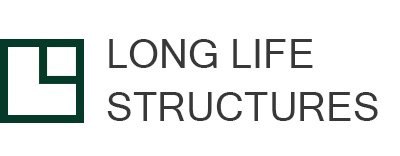Timber Frame approach to both Passive House and NZEB.
Designing and building to NZEB and Passive house.
Designing and building to NZEB and Passive house.
Timber Frame approach to both Passive House and NZEB.
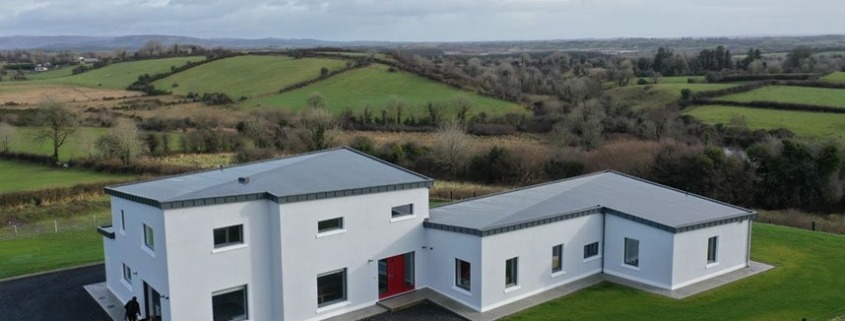
“The timber frame makes a big difference in performance… It was a lot easier to ensure airtightness early whereas the house is practically finished by the time you are able to test airtightness on a cavity wall-built house.” Mark Stephens, Architect.
With modern house design, we see a lot more design features and large openings which work quiet easily into timber frame as opposed to concrete traditional building methods, which uses a lot of structural steels and more detailing to avoid thermal bridging. With timber frame construction, these issues are eliminated with the use of timber lintels, glulam beams and encapsulated steel structural elements and steel connections using thermal plates. We use blown cellulose in our walls and roof area which fills the voids and spaces between timber frame wall panels.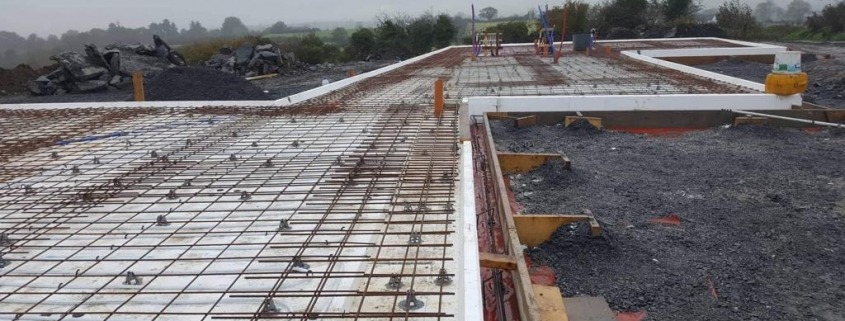
The architects design included a geothermal heat pump with mechanical ventilation with heat recovery. The timber frame components work well along side mechanical and electrical systems with access for ventilation ducting, service voids for electrical and plumbing – all of which can be designed and planned at the early project stage saving time and money.
The airtightness is also an area that is designed into the structure early on so that air leakage and air infiltration is avoided which can damage the structure.
Long life Structures have over 60 homes build to these high standards, achieving passive house airtightness standards before the nearly zero energy building (NZEB) standards came into effect. These standards now apply to all new buildings occupied after the 31st December 2020. We strive to be innovative and stay ahead of the trend when it comes to building highly efficient thermal envelopes, we are thermal envelope specialists.
If you are interested in reading more of the article on this beautiful home in Mayo, designed by Mark Stephens Architects, you can view it on passive house plus magazine. https://passivehouseplus.ie which now has an online version of the magazine for anyone interested in keeping up to date with these fantastic homes.
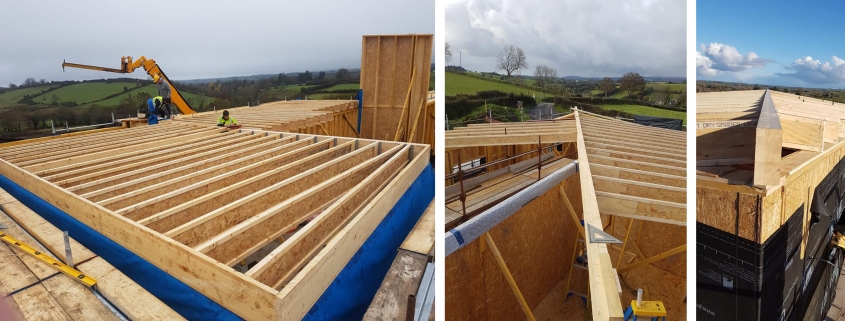
Our Wall Specification used in this build:
100 mm rendered concrete blockwork externally with a 50 mm unventilated cavity to pro clima Fronta WA membrane to 9 mm plywood sheathing fixed to 220 x 44 mm structural studs. The walls are filled with cellulose insulation, blown in on site by specialist contractor. This fill all voids and cavities within the timber stud wall. Intello airtightness membrane internally with a 50 mm service cavity insulated with 50mm sheep wool insulation. A 15 mm Gyproc Plasterboard is installed by others internally to the service battens.
U-value: 0.164 W/m2K (accounts for studs & battens)
The Roof Specification for this project in Ballina:
Alkor fully bonded PVC with seams, with Novaplex coated steel soffit and fascia, followed beneath by 18 mm plywood sheathing, 38 mm ventilated cavity, pro clima Solitex Plus membrane to 300 mm timber I-joists fully filled with cellulose insulation, Intello airtightness membrane, 50 mm uninsulated service cavity, 15 mm Gyproc Plasterboard.
U-value: 0.136 W/m2K
Materials:
With our fabric first build system we use green materials for our walls and roofs. Wood for the timber frame is FSC and PEFC certified, sourced from environmentally responsible forests. Walls and roofs and densely packed blown cellulose insulation. We provide sheeps wool insulation to be installed at a convenient stage of the builder/client.
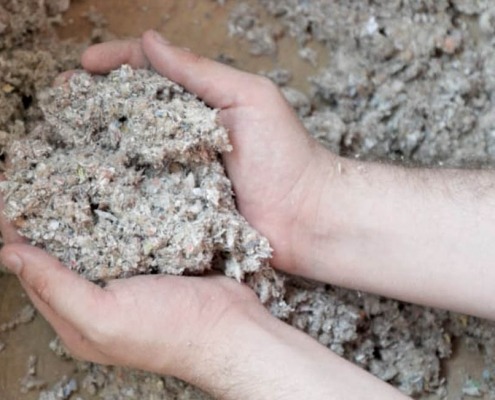 https://www.llstructures.ie/wp-content/uploads/2021/03/Cellulose-loose.jpg
651
858
Longlife Editor
https://www.llstructures.ie/wp-content/uploads/2021/03/logo-header-lls-1-1.jpg
Longlife Editor2021-03-10 16:47:272021-03-10 18:13:23What is Cellulose Insulation and Why use it?
https://www.llstructures.ie/wp-content/uploads/2021/03/Cellulose-loose.jpg
651
858
Longlife Editor
https://www.llstructures.ie/wp-content/uploads/2021/03/logo-header-lls-1-1.jpg
Longlife Editor2021-03-10 16:47:272021-03-10 18:13:23What is Cellulose Insulation and Why use it?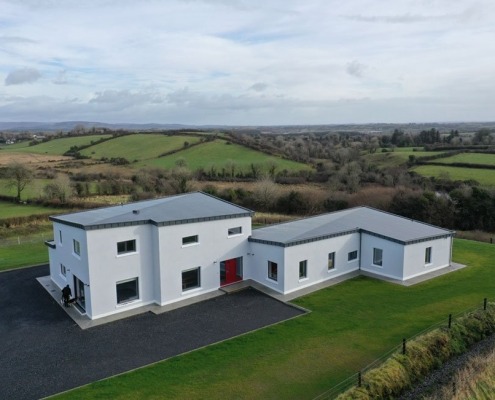 https://www.llstructures.ie/wp-content/uploads/2021/03/castlebar-passive-house-timberframe-1.jpg
651
858
Longlife Editor
https://www.llstructures.ie/wp-content/uploads/2021/03/logo-header-lls-1-1.jpg
Longlife Editor2021-03-10 16:37:332021-03-11 15:13:09Timber Frame approach to both Passive House and NZEB.
https://www.llstructures.ie/wp-content/uploads/2021/03/castlebar-passive-house-timberframe-1.jpg
651
858
Longlife Editor
https://www.llstructures.ie/wp-content/uploads/2021/03/logo-header-lls-1-1.jpg
Longlife Editor2021-03-10 16:37:332021-03-11 15:13:09Timber Frame approach to both Passive House and NZEB.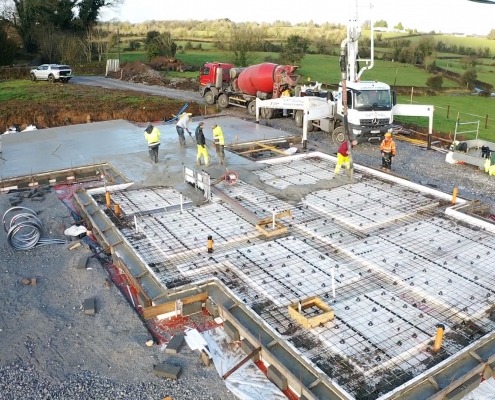 https://www.llstructures.ie/wp-content/uploads/2021/03/Insulated-Foundation-Concrete-Concrete-Pump-Underfloor-heating.jpg
1080
1632
johno
https://www.llstructures.ie/wp-content/uploads/2021/03/logo-header-lls-1-1.jpg
johno2021-03-10 10:35:372021-03-13 21:58:24Insulated Foundations
https://www.llstructures.ie/wp-content/uploads/2021/03/Insulated-Foundation-Concrete-Concrete-Pump-Underfloor-heating.jpg
1080
1632
johno
https://www.llstructures.ie/wp-content/uploads/2021/03/logo-header-lls-1-1.jpg
johno2021-03-10 10:35:372021-03-13 21:58:24Insulated Foundations
 What is Cellulose Insulation and Why use it?
What is Cellulose Insulation and Why use it?This site uses cookies. By continuing to browse the site, you are agreeing to our use of cookies.
Accept settingsSettingsWe may request cookies to be set on your device. We use cookies to let us know when you visit our websites, how you interact with us, to enrich your user experience, and to customize your relationship with our website.
Click on the different category headings to find out more. You can also change some of your preferences. Note that blocking some types of cookies may impact your experience on our websites and the services we are able to offer.
These cookies are strictly necessary to provide you with services available through our website and to use some of its features.
Because these cookies are strictly necessary to deliver the website, refuseing them will have impact how our site functions. You always can block or delete cookies by changing your browser settings and force blocking all cookies on this website. But this will always prompt you to accept/refuse cookies when revisiting our site.
We fully respect if you want to refuse cookies but to avoid asking you again and again kindly allow us to store a cookie for that. You are free to opt out any time or opt in for other cookies to get a better experience. If you refuse cookies we will remove all set cookies in our domain.
We provide you with a list of stored cookies on your computer in our domain so you can check what we stored. Due to security reasons we are not able to show or modify cookies from other domains. You can check these in your browser security settings.
These cookies collect information that is used either in aggregate form to help us understand how our website is being used or how effective our marketing campaigns are, or to help us customize our website and application for you in order to enhance your experience.
If you do not want that we track your visit to our site you can disable tracking in your browser here:
We also use different external services like Google Webfonts. Since these providers may collect personal data like your IP address we allow you to block them here. Please be aware that this might heavily reduce the functionality and appearance of our site. Changes will take effect once you reload the page.
Google Webfont Settings:
You can read about our cookies and privacy settings in detail on our Privacy Policy Page.
Privacy Policy